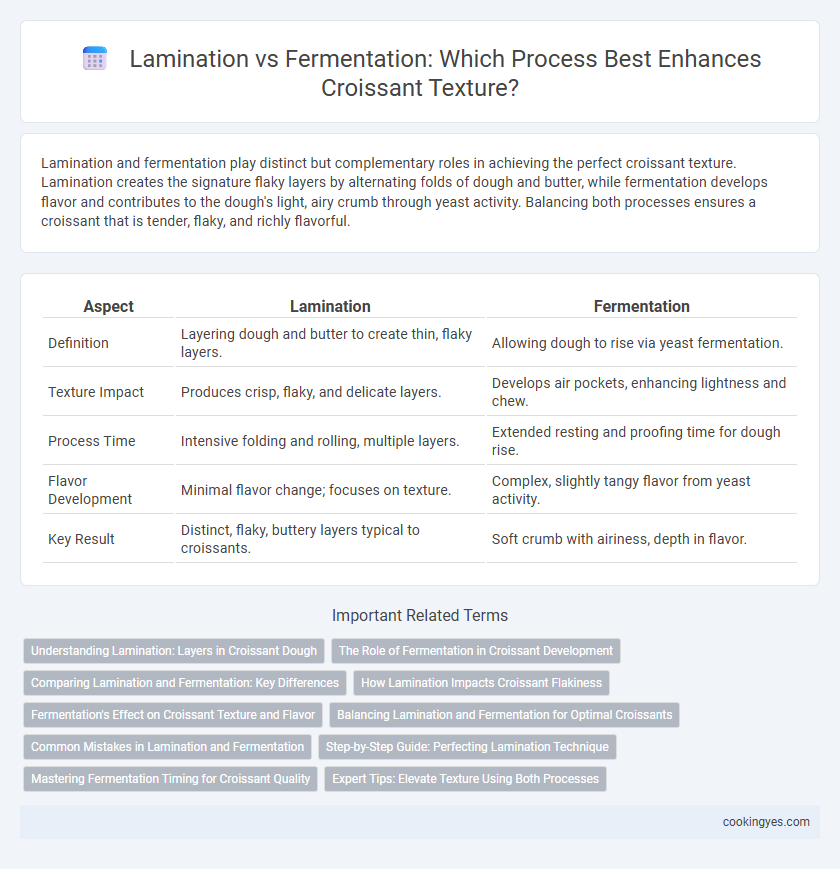Lamination and fermentation play distinct but complementary roles in achieving the perfect croissant texture. Lamination creates the signature flaky layers by alternating folds of dough and butter, while fermentation develops flavor and contributes to the dough's light, airy crumb through yeast activity. Balancing both processes ensures a croissant that is tender, flaky, and richly flavorful.
Table of Comparison
| Aspect | Lamination | Fermentation |
|---|---|---|
| Definition | Layering dough and butter to create thin, flaky layers. | Allowing dough to rise via yeast fermentation. |
| Texture Impact | Produces crisp, flaky, and delicate layers. | Develops air pockets, enhancing lightness and chew. |
| Process Time | Intensive folding and rolling, multiple layers. | Extended resting and proofing time for dough rise. |
| Flavor Development | Minimal flavor change; focuses on texture. | Complex, slightly tangy flavor from yeast activity. |
| Key Result | Distinct, flaky, buttery layers typical to croissants. | Soft crumb with airiness, depth in flavor. |
Understanding Lamination: Layers in Croissant Dough
Lamination in croissant dough involves folding butter into the dough multiple times to create thin, alternating layers of butter and dough, which results in the flaky, crisp texture unique to croissants. These layers expand when baked due to steam generated from the butter and water content, producing a light and airy interior with a golden, crispy exterior. Proper lamination is essential to achieve the characteristic texture, as improper technique can lead to dense or uneven crumb structure.
The Role of Fermentation in Croissant Development
Fermentation plays a crucial role in croissant development by producing carbon dioxide that expands the dough, creating the airy, open crumb characteristic of well-made croissants. The natural yeast activity also enhances flavor complexity through the production of organic acids and alcohols, contributing to the croissant's rich, tangy taste. Proper fermentation time balances dough elasticity and proofing, ensuring optimal lamination layers separate effectively for a flaky, tender texture.
Comparing Lamination and Fermentation: Key Differences
Lamination creates flaky, layered texture in croissants by incorporating butter between dough folds, while fermentation develops flavor and dough elasticity through yeast activity. Lamination directly affects the croissant's crispiness and height, whereas fermentation influences the crumb structure and taste complexity. Balancing both processes is essential to achieve the ideal croissant texture combining light, airy layers with rich, nuanced flavors.
How Lamination Impacts Croissant Flakiness
Lamination creates thin layers of butter and dough that generate steam during baking, causing the croissant to puff and develop its characteristic flakiness. Proper lamination ensures crisp, distinct layers that separate easily, contributing to a light and airy texture. In contrast, fermentation primarily affects flavor and rise, but lamination directly determines the croissant's signature flaky structure.
Fermentation's Effect on Croissant Texture and Flavor
Fermentation significantly enhances croissant texture by developing gluten structure, which contributes to a tender crumb and improved flakiness. Yeast fermentation produces organic acids and alcohols that deepen flavor complexity, creating the characteristic slightly tangy and rich profile of traditional croissants. Controlled fermentation time and temperature directly influence dough rise, gas retention, and flavor development, making it a critical factor in high-quality croissant production.
Balancing Lamination and Fermentation for Optimal Croissants
Balancing lamination and fermentation is crucial for achieving the ideal croissant texture, where precise lamination creates distinct, flaky layers while controlled fermentation develops flavor and dough elasticity. Over-lamination can cause dense layers, whereas insufficient fermentation results in bland, tough pastries, making timing and temperature key factors. Optimal croissants emerge from harmonizing the lamination's thin, even butter layers with a fermentation process that enhances yeast activity and dough rise.
Common Mistakes in Lamination and Fermentation
Common mistakes in croissant lamination include uneven dough rolling and improper temperature control, leading to inconsistent layers and a dense texture. During fermentation, overproofing or underproofing can cause poor rise and a gummy crumb. Balancing lamination precision with optimal fermentation timing is crucial for achieving the signature flaky, airy croissant.
Step-by-Step Guide: Perfecting Lamination Technique
Mastering the lamination technique involves carefully folding and rolling butter into the dough to create multiple thin layers, essential for a flaky croissant texture. Precise temperature control during lamination prevents butter from melting and ensures distinct layers that puff beautifully during baking. Proper fermentation follows lamination, allowing yeast to develop flavor and dough elasticity, but the lamination step is critical for achieving the signature airy, crisp croissant structure.
Mastering Fermentation Timing for Croissant Quality
Mastering fermentation timing is crucial for achieving the ideal croissant texture, as precise control allows yeast to develop optimal gas production, resulting in a light, airy crumb. Proper fermentation balances dough acidity and gluten structure, enhancing lamination layers that create the flaky, buttery exterior. Accurate timing avoids overproofing, which can cause collapse, or underproofing, yielding dense, chewy croissants lacking the signature delicate flakiness.
Expert Tips: Elevate Texture Using Both Processes
Achieving the perfect croissant texture hinges on mastering both lamination and fermentation, where lamination creates delicate, flaky layers by incorporating butter into dough through repeated folds. Controlled fermentation enhances flavor and dough elasticity, allowing proper gluten development and gas retention for airy, tender crumb structure. Experts recommend balancing precise fermentation times with optimal lamination techniques to elevate croissant flakiness and flavor complexity simultaneously.
Lamination vs Fermentation for Croissant Texture Infographic

 cookingyes.com
cookingyes.com